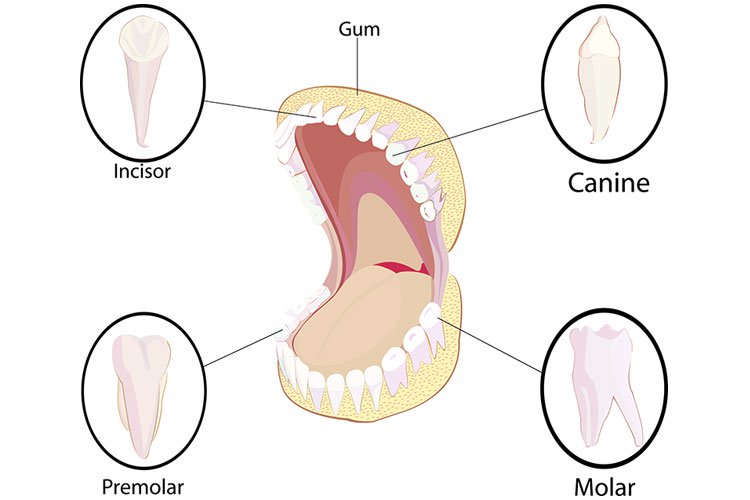What are the types of teeth in my mouth?
Updated August 19, 2016
Have you ever considered all the structures in your mouth? From the hangy down thing in the back of your mouth to the multiple types of individual teeth, there is a lot of stuff going on in your mouth!
When you care for your teeth, smile for the camera, and laugh with your mouth wide open, you probably consider whether your teeth look good. But what are those teeth doing in there? Why are some of them different? Here are the basics when it comes to what's in your mouth.
Incisors
Your incisors are the front four teeth on the top and bottom. They help you with that first bite of food, and are generally the teeth we pay the most attention to because they are the most visible when we talk and smile. They are most often the teeth we cut first as babies, and lose first before our adult set comes in.
Canines
Your canines come in around the incisors with the purpose to rip and tear through foods. They are going to be your sharpest teeth, and you have four total. When you get your adult teeth in, you'll see the bottom canines come in before the top. However, the opposite occurs when you are cutting your first canines.
Premolars and molars
Premolars and molars are both used to grind and chew food. They are the largest teeth in your mouth, and have two to three roots holding them in place. Even though these aren't as visible or sharp as other teeth in your mouth, it's important that you take good care of them!
Third molars
Third molars also have the name wisdom teeth because they will be the last of the teeth that erupt. (You'll usually see these after the age of seventeen, when you're supposed to have gained a lot of wisdom!) However, some people may never see their wisdom teeth come in. Depending on the space in the mouth and the orientation of the wisdom teeth as they come in, people have to have these teeth removed.
We don't actually need our wisdom teeth anymore, and anthropologists believe they were an evolutionary answer to a harder to chew diet that caused more wear on our teeth.
What makes up your teeth?
Now that you know all about the different styles of teeth you have, what's inside?
The white part that we see every day is called the crown. The root (hidden below the gums—unless something is wrong!) keeps the tooth in place by anchoring it to the bone.
There are also four types of tissue that work to protect your mouth. Enamel, which is harder than bone, covers your crown and protects it from decay. Dentin is under the enamel and also helps protect it against decay. It's not as strong as enamel, but still acts as a second defense line should the enamel get damaged.
Cementum covers and protects the root. Taking proper care of your gums should keep them from receding, and will help protect this softer tissue from being exposed. Pulp delivers nutrients to your teeth and also provides them with important signals.
What else is in your mouth?
There are quite a bit of structures packed into a tiny area like your mouth. In addition to housing your teeth, your mouth is the home to your uvula, tonsils, and tongue, just to name a few.
Uvula
The palatine uvula is the little hangy down thing in the back of your throat. The uvula has a couple of different purposes. One purpose of the uvula is to act as a cover for your nasal cavity when you swallow food. Without this handy device, you would get food up into your sinuses and nasal passages which are both uncomfortable and disgusting. There is another danger that could be posed if your uvula didn’t keep the food out of your nasal cavity. By allowing nasal regurgitation to occur, you would introduce bacteria from your mouth and chewed up food into your sinuses and could cause an infection. The other purpose of the uvula is to produce needed saliva. The uvula helps us as humans with speech. If you have ever had to talk in public in front of a large crowd, you know your mouth goes dry. Your uvula is there to expel extra and needed saliva for you to continue with your speech!
Tonsils
The two large pink blobs of tissue in the back of your mouth to the sides of your uvula are known as your palatine tonsils. We also have two more tonsils that you are unable to see that are located at the base of your tongue. These are known as the lingual tonsils. The purpose of the tonsils is that of an enlarged lymph node. Lymph nodes are crucial in the body because they trap bacteria, viruses, and other invaders and send them to the spleen. In addition, the spleen then filters the microorganisms and creates white blood cells (lymphocytes) to go and fight the invaders to stop infections from spreading.
Tongue
The largest structure in your mouth is probably that of the tongue coming in at three to four inches in length. The tongue is a solid muscular organ located in the center of the mouth. It is covered with pink tissue called mucosa which has tiny projections called papillae on it. This is what gives the tongue its rough texture. On each papillae are thousands of taste buds that allow us to taste foods that are bitter, sour, salty, and sweet. Salt is sensed first because it dissolves rapidly in water and is usually the first thing you notice, even before sugar!
Proper care
As is common with our teeth, it's easy not to think about them as long as everything looks and works properly, but that doesn't mean you should forget about them! Remember to properly care for your teeth by flossing and brushing on a regular schedule. Be sure you're making your check-ups with your dentist, and ask them any questions you have about your teeth.






